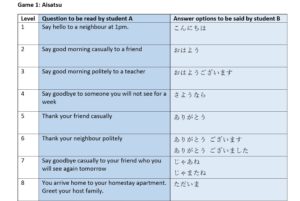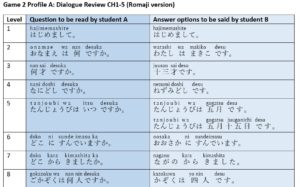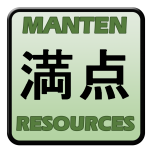When programming for the new syllabus, I noticed that I needed to create more opportunities for the students to meet the outcome LJA4-1C, in particular the following content point: “engage in collaborative activities that involve planning and making arrangements for example participating in class activities using set phrases in Japanese” (ACLJAC002).
Although we played games in my classes, I wanted to embed more target language use into the games and the way the students played together.
The result is the Speaking Stations Pack. The first of these packs to be released is aimed at Stage 4 (year 7/8). This version develops a student’s skills in the language content covered in Jblog textbook 1.
How to play
Students in pairs or small groups have a map of Mt Fuji that has 15 speaking stations. Student A throws a dice and moves along the path the number of places on the dice. Student B uses the question card to ask Student A the matching question for that station eg 「何才ですか」. Student A refers to their stimulus card which provides information in Japanese to help them answer the question. If Student A answers correctly, they can stay on the station. If they answer incorrectly, they must go back to the start. Student B is responsible for telling Student A if they are correct or not. Student B has the answers written on the question card. Students take turns rolling the dice and answering the question.
This game can be differentiated in two ways.
Firstly, each game has a script version (hiragana and basic kanji) and a romaji version (with romaji above the Japanese script). Students or teachers can select which is more appropriate for individual students.
Secondly, students can use the same question card or different question cards. For example, student A could be using the Dialogue Review Profile A card and student B could be using the Dialogue Review Profile D card.
 click on image to view enlarged version
click on image to view enlarged version
What topics are covered?
This Year 7/8 version covers the following topics:
Game 1 – Aisatsu
This game revises common aisatsu and has questions in English such as You arrive home to your homestay apartment. Greet your host family. The student would be expected to say “ただいま”.
Game 2 – Dialogue Review CH1-5
This game revises common self-introduction content such as name, age, birthday, number of people in your family etc. Students must refer to the profile they receive of a Japanese person to answer each question. The profile is provided in Japanese in a table format. The students use the stimulus to create an appropriate full sentence to respond. There are 3 versions of game 2 that use different Japanese profiles.
Game 3 – School life
This game revises common school life content such as if they like or dislike a subject, what period or day of the week they study a subject, what their favourite subject is etc. Students must refer to the profile they receive of a Japanese person to answer each question. The profile is provided in Japanese in a table format. The students use the stimulus to create an appropriate full sentence to respond. There are 3 versions of game 3 that use different Japanese profiles.
Game 4 – Shopping at the Bunkasai
This game revises content related to shopping, prices and classroom objects. The setting is purchasing classroom objects from a stall at the bunkasai. Students will be required to use Japanese language to ask what an item is, how much it costs, to pass items and to say thank you etc. There are 3 versions of game 4 that use different stimulus information.
 click on image to view enlarged version
click on image to view enlarged version
Composing option
Teachers may also like to follow this speaking task with a composing option. There are blank tables provided, that students could use to create their own versions of the game by composing the profiles/stimulus cards and sample answer cards. This activity would address the composing outcome LJA4-4C, in particular the content point, “Compose informative and imaginative texts in spoken, written and multimodal forms for a variety of purposes and audiences, using stimulus materials and modelled language (ACLJAC007).”
How much does it cost? What do I receive in the pack?
The pack costs $50 and includes:
- A Mt Fuji game sheet with 15 stations
- Game 1 – Aisatsu
- Game 2 – Dialogue Review with 3 different profile versions
- Game 3 – School Life with 3 different profile versions
- Game 4 – Shopping at the Bunkasai with 3 different stimulus cards
- All games include a scripted version and a romaji version
- Student game explanation with suggested language to use when playing the game such as はい、どうぞ。(When passing the dice to each other.);さいころはどこですか。Where is the dice?; わたしのばん It is my turn.
- Scaffolds to support the composing option of the game
- Teacher guide
Teachers will receive all these items as PDFS or word documents. It is recommended that you laminate the game sheet. Teachers will need to supply their own dice and markers for the game.
To order, email jblog1help@gmail.com
